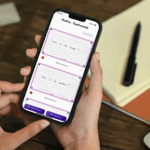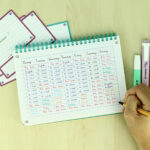
Revising maths: our top tips
Revising maths: our top tips
Revising maths
Revising maths can feel like a challenge with all those formulas and theorems to learn. Luckily, there are some simple and effective revision methods to help you out. Check them out in our article!
Ah, maths… the subject so many dread! At first glance, revising maths doesn’t seem like much fun. Between all the definitions, theorems, and formulas, it’s easy to get confused or miss something important.
But good news – there are simple and effective ways to revise that’ll help you understand, remember, and apply mathematical concepts. Because let’s face it, revising maths isn’t the same as revising history or French. So, to help you smash it on exam day, here are our top tips for revising maths! 💯
Go over the essentials
Create effective revision notes.
As you probably know, every subject calls for a different revision approach. For maths, it’s all about using the right method – otherwise, you could end up staring at your paper like it’s written in hieroglyphs. 👉 In short, maths is a combo of understanding and memory.
You need to get your head around key principles and remember the right formulas to apply them. In maths, winging it just won’t cut it. If you don’t understand the question or know which calculation to do, you’re likely to hand in a blank page.
To avoid that, you need to know your course content. And that’s where revision notes come in! Writing them out by hand helps you retain information and focus on what really matters.
📍 A good maths revision note usually includes :
- Key properties,
- Theorems,
- Definitions,
- Formulas,
You don’t need to memorise every single thing – just focus on the core ideas. For instance, if you’re making notes on decimal numbers, include:
- Key definitions (whole number and decimal number),
- Clear examples,
- A box with key points to remember.
💡 Pro tip (you’re welcome 😎) : Use colour (highlighters, pens, etc.), visuals and boxes to break things up and make your notes easier to digest. Box your formulas, highlight your definitions, and mark examples with arrows or emojis. Make your notes your own and fun to look at!
Use the Flashcard method
Struggle to memorise definitions and formulas? No worries! Oxford’s FLASH 2.0 flashcards are perfect for revising maths – colourful, sturdy, and way more fun than staring at your textbook.
👉 Each card has two sides: a question on the front and the answer on the back. For example:
- How do you calculate the area of a circle? (front)
● Using the formula π × radius² (back)
It’s a brilliant way to learn because it really makes your brain work. Instead of just passively reading, you’re actively testing yourself – which helps you remember better!
💡 Even better, you can pair your flashcards with the Scribzee app. Scan them in and revise anytime, anywhere using the app’s Revision mode. The cards appear one at a time, and you swipe left (to review again) or right (if you’ve got it) depending on how confident you feel.
Plus, Scribzee uses spaced repetition – a clever technique for long-term learning. The app keeps track of which cards you’re struggling with and brings them back more often until you’ve nailed them. Pretty cool, right? 😌
Review class exercises
Revising maths isn’t just about memorising stuff. To really get it – and ace your exam – you need to practice using the concepts you’ve learned. In maths, theory and practice go hand in hand !
👉 Take the formula π × radius² again.
If you just learn it by heart without ever using it, you might freeze up when it actually comes to applying it in an exam. But if you’ve practiced with real examples in class exercises, you’ll feel much more confident.
We recommend going over the exercises your teacher has already corrected. If you get stuck, have a quick look at the first step of the solution to get going, then try finishing it on your own. ✨
Then go back and read the full solution carefully. Pay attention to how the question is worded, what concepts are used, and how the problem is solved step by step. Understanding how and why each step is taken really helps solidify your knowledge.
💡 Want to stay on top of practice? Use Scribzee’s Calendar feature to create a personalised revision schedule. You can plan your sessions directly in the app, sync with Google Calendar, or scan dates from your Oxford paper planner.
Practice with exercises
Depending on what exam you’re preparing for, it’s a good idea to find extra practice questions to work on. Practice is key when it comes to maths! This is your chance to apply everything you’ve learned with your flashcards. 💪
If you’re studying for your GCSEs or A-levels, past papers are one of the best ways to prep. Re-doing previous exams helps you::
- See what you know – and what still needs work
● Spot common question types
● Understand what examiners are looking for
● Get used to the exam format and time pressure
The more past papers you do, the more confident and experienced you’ll become. You’ll learn how to manage your time, stay focused, and write clear answers (don’t worry – no essays required 🙅). Basically, it’s a win-win!
💡 Use Scribzee’s Reminder tool to schedule your extra practice sessions. Regular practice boosts memory and keeps you sharp right up to exam day.
In summary
Now that you’ve got our top tips for revising maths, all that’s left is to grab your favourite pen, make some flashcards, and dive into those practice exercises. Remember – practice really is one of the keys to success in maths. Good luck – you’ve got this! 😉




Your email address will not be published.